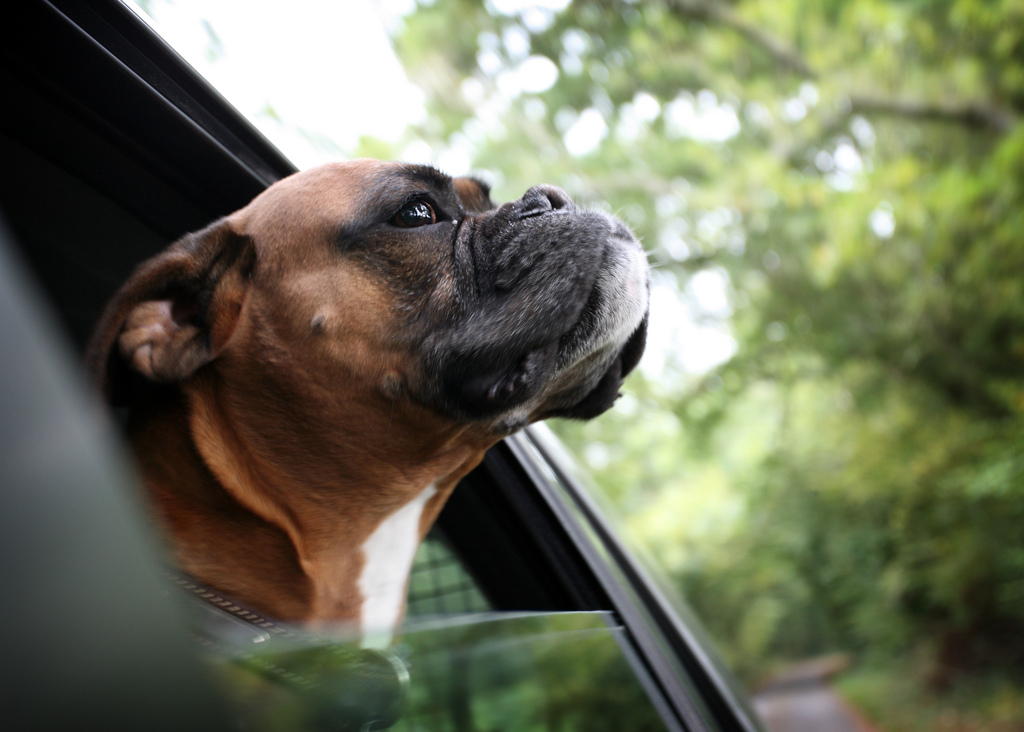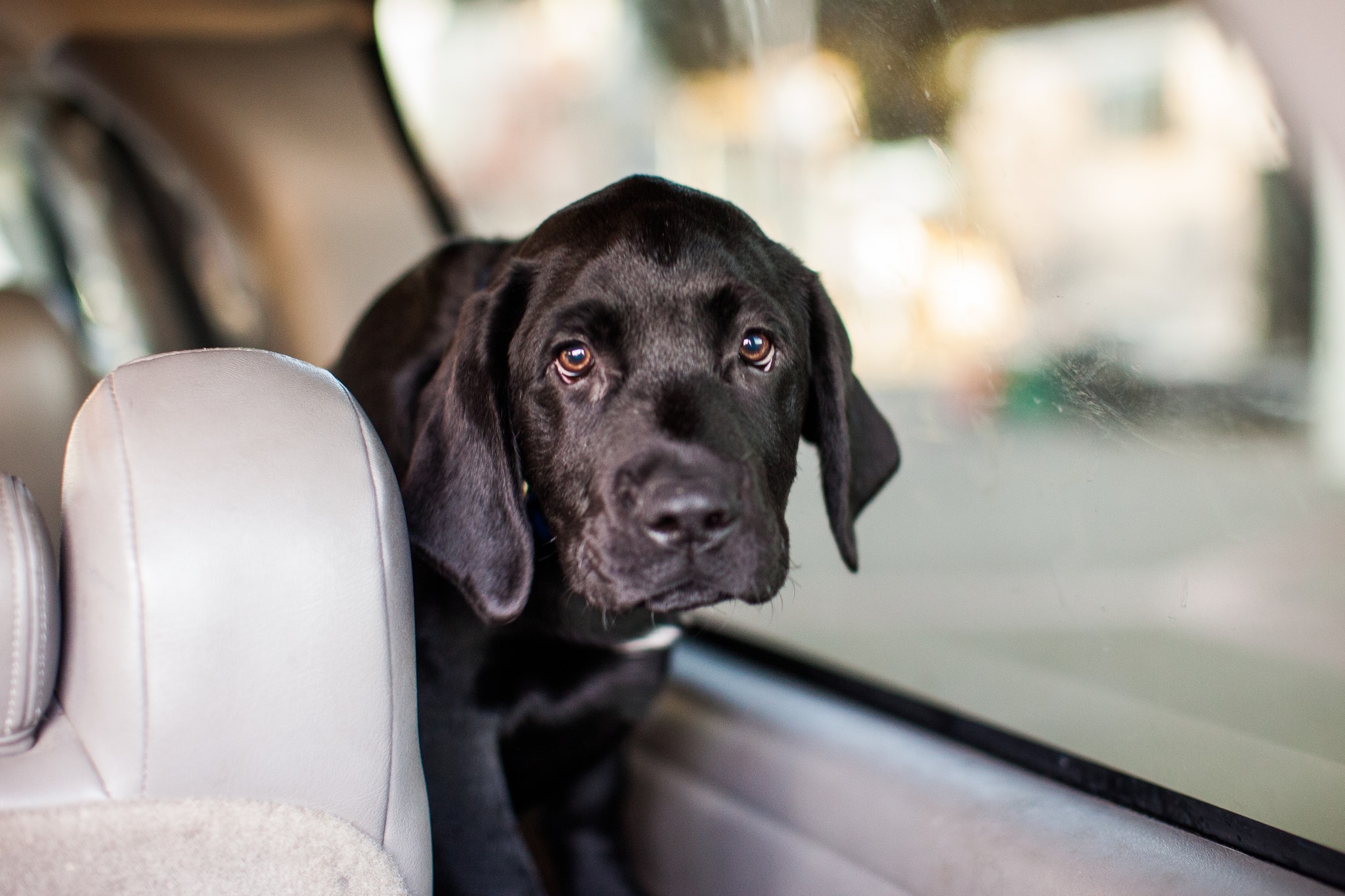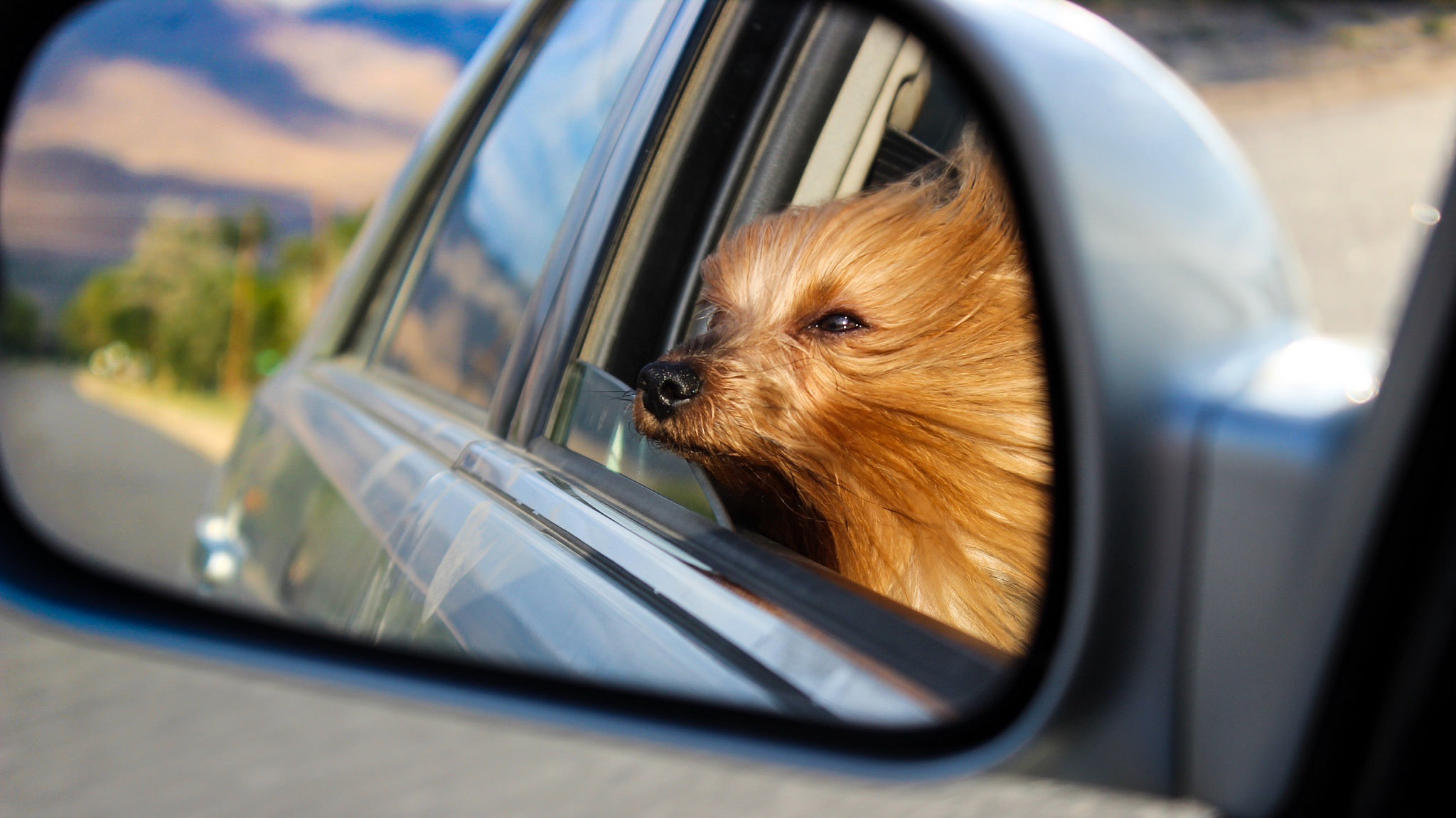4 Valuable safety tips for driving with your dog

A cool breeze in your face, the open road ahead of you and a smiling dog by your side: What could be better?
If you’re like many people, you drive with your dog in the car. A lot.
From quick visits to the dog park to cross-country road trips, driving with your dog can be an enjoyable adventure.
But while driving can be a fun bonding experience between dog and dog-owner, it can also pose a few safety risks for both pets and humans.
Luckily for you, you’re here!
For your peace of mind, we’ve done our research and compiled the most important safety tips to consider when you take your pup with you in the car. By the end of this article, we hope you’ll have all of the tools you need to prepare for the (literal) road ahead of you.
If you’re in a hurry, the 4 valuable tips are: train your dog to love the car, make it easy for your dog to get in and out of the car, plan ahead and buckle up! Read on for all the details.
Safety by the numbers
So, what’s the big deal with having dogs in the car, anyway?
According to this AAA survey, more than 52 percent of people drive at one point or another with their dog in the car. With 78 million dogs in U.S. households, that’s a LOT of dogs on the road.
Of people who drive their dogs, 65 percent report engaging in distracting activities.
Think: playing, petting, or attempting to restrain a dog while driving.
With distracted driving injuring over 300,000 people yearly (not to mention pets!), aiming for safety in the car is no joke.
Create a safety plan that works for you
Just as everyone’s puppy is unique, everyone’s driving situation is unique.
What works for one dog parent in terms of safety may not work for another, and vice versa.
As an owner you must decide – based on your vehicle, travel habits, dog and choice of accessories – what is best for you in terms of car safety.
But don’t worry! While it’s easy to be overwhelmed by all of these options, we’re here to help. By giving you an overview of car safety issues big and small, we hope that you’ll feel confident enough by the end of this article to create a car safety plan that works for you, your lifestyle and your pup.
Major car safety considerations
As dog owners, we want to keep our dogs safe at home, at the park or in the car.
When driving with your dog, the biggest safety risks include:
- Having your dog cause an accident
- Having your dog get injured in an accident
There are many ways to minimize these risks, from training your dog to behave in the car to restraining your dog in one way or another. As you read through the following list of safety tips, be sure to keep these two major risks in mind.
If you can keep your dog from causing an accident or getting injured while in the car, you’re on the right track!

Keep your pup as safe as can be on any ride. Image: Thomas Hawk
Tip #1: Train your dog to love the car
Did you know that car safety starts before you ever begin driving?
Training your dog to do anything, from fetching to socializing, is a great way to create a happy home environment for both dog and owner, and training your dog to love the car is no different.
While some dogs naturally love the car, this is definitely not the case for all dogs. If a dog is not properly trained for car rides, the dog can be very disruptive, increasing the probability of distracted driving.
Remember: Distracted driving means an increased chance of getting in an accident. So, to decrease the chance that your dog will be a distraction, you need to train them to love the car.
How to train your dog to love the car
Most dogs are naturally nervous about new things, people and experiences.
If a dog has never ridden in a car before, it’s best not to take them for a 5-hour road trip right out of the gate. You also shouldn’t ONLY take your dog to places they don’t like (like the vet) in the car. This will cause your dog to have a negative association to the car when you want a positive association.
For training purposes, it’s best to start your dog off slow and eventually incorporate car rides into your weekly routine.
Step-by-step training plan
Step one: The first time you introduce your dog to the car, don’t even go for a ride! Put your dog in the car, tell them to sit, and give them a treat and praise. Do this two or three times before you ever start the engine.
Your dog will begin to associate the car with “good things” instead of “bad things.” Positive reinforcement will make your dog feel safe and eventually they will love the car.
Step two: On your first car trip with your pup, we recommend that you bring someone else with you to drive so that you can focus on training your dog. Your friend can worry about distraction-free driving.
Go on a short drive to somewhere your dog enjoys: the dog park or friend’s house, for instance. Give your puppy rewards (praise and treats) for laying down, being calm, staying in the back seat, or generally for behaving how you want.
Note: Training your dog for the car is best done after your dog has exercised. If your dog is full of energy, it’s more difficult to get them to calm down or even sleep in the car. We recommend that you take them for a walk before car training.
Step three: Go on a short drive, just you and your dog. Be sure to stay in a relatively non-trafficked area, just in case you have to pull over. If the journey is a success, you are ready to hit the road!
If you have trouble, just go back to step two and continue training until your dog is calm, happy and safe in the car. Overall, take it slow and listen to your dog.
Once a dog is ready to be in the car for a longer amount of time, you’ll know. A lot of dogs will even sleep in the car once they are properly trained.

Training your dog to enjoy the car takes effort, but it’s worth it! Image: Maryland GovPics
Tip #2: The ins and outs of dog car safety
A huge part of ensuring your dog’s safety in the car actually has nothing to do with driving. Whenever you take your dog for a drive, you have to consider how your dog will get in and out of the car.
Depending on the size of your vehicle, your dog may have difficulty getting in and out of the car without assistance. From puppies to older dogs, getting in and out of the car present their own unique challenges for each dog.
Luckily for you, there are a few options when it comes to getting your dog in and out of the car. The three main options you have are:
- Dog steps and ramps
- Lifting your dog
- Letting your dog jump
Dog steps and ramps
Dog steps or ramps are ideal for older dogs of any shape and size that are used to getting in and out the car by themselves but no longer can.
If your dog has weight issues, hip or elbow dysplasia, arthritis or is simply getting old, letting them get in and out of the car by themselves can be a huge car hazard. Along with dog harnesses designed to help lift the back legs, steps and ramps make travel significantly safer for old dogs.
While you’ll have to do your own research about the best ramps and folding steps for own your car, these tools in general are a great option to get your pup in and out of the car safely as they age.
Lifting your dog
Unless you’re a bodybuilder, you probably won’t be able to lift your Saint Bernard into the car. If you have a smaller dog like a Dachshund, however, you have the option to lift your dog in and out of the car.
While this may not be everyone’s choice, it’s a safe choice if your dog is on the smaller side or a young, small puppy.
Letting your dog jump
Dog owners frequently let their dogs jump in and out of the car independently. This method of getting in and out of the car is good for young, agile and athletic larger dogs. While this is a quick, easy way to transport your dog, it’s not necessarily the safest way.
It’s important to keep in mind that jumping too much may cause your dog to have issues later in life like hip dysplasia and joint problems, but that shouldn’t hinder you from letting your dog jump every once in a while.
Be sure to stand near your dog when letting them jump in and out of the car, just in case you need to assist them. We also recommend that you keep a leash on your dog throughout the process until the car is completely shut, just to be safe.
If you’re still having questions about getting your dog in and out of the car, check out this quick tutorial:
Tip #3: Plan, plan, plan
Preparing for the unknown is the best safety plan when it comes to driving with your dog.
If you ever find yourself in an emergency situation (in an accident, broken down, or experiencing a medical issue) with your dog in the car, having a plan is essential.
Create an emergency plan
There are two parts to every good emergency plan: mental preparation and physical preparation.
When mentally preparing for an emergency situation with your dog in the car, think through what you will do if you find yourself broken down or in an accident.
While the choice is ultimately up to you, we recommend that you make sure:
- Your dog is on a collar and leash before exiting the vehicle
- Your dog exits the car from the door opposite the road
If your dog is in an unfamiliar or stressful situation, they may panic and run or bolt into the road. In order to avoid this, make sure your dog remains calm and on a leash when in an emergency situation on the road.
When physically preparing for an emergency situation, it is always best to carry extra supplies for your pup. Some recommended supplies include:
- Extra food
- Extra water (for you and your dog)
- Extra bowl
- Leash, collar and dog tag
- First-aid kit
- Your pet’s vet records
- A chew toy (to distract your dog, especially if they are a puppy)
For more general tips and tricks when traveling, make sure to check out our article on traveling with your dog: things to know before you go.

Small dogs can just be lifted into your car. Image: RStonejr
Tip #4: Buckle up
Perhaps the most important car safety tip when driving with your dog is making sure that your dog is restrained in one form or another.
Restraining your pup serves two main purposes:
- A restraint keeps your dog away from you, the driver
- A restraint keeps your dog from flying out of the window in case of an accident
Options for restraining your canine in the car
There are many options when it comes to restraining your dog. You can use a harness, a car hammock, a seat blocker, a crate or a combination of these options.
With a cozy blanket or car hammock being the least restrictive to a crate or 3-point harness and seat belt being the most restrictive, we recommend that you do your own research to figure out which “buckle up” method works best for you, your dog’s size and your dog’s personality.
Final things to consider when driving with your dog
Where your dog actually sits in the car is very important.
While it is your choice whether or not you want your dog to ride in the front seat, it is not recommended. Generally, the safest place for your dog in the car is in the back seat with the windows up.
Dogs in the front seat can accidentally shift the car’s gear stick (yikes!), climb onto your lap (distracted driving alert), or get injured by the airbag if it inflates. Having the windows up ensures that your dog isn’t hit by debris and keeps their arms and paws safely in the vehicle at all times.
Ready, set, drive safely
Driving with your dog can be a fun bonding experience and part of your weekly (or even daily) routine.
Being able to bring your fur baby with you wherever you go with minimal stress is going to make both your and your dog’s quality of life much better.
So, train your pup to love the car, create an action plan for car safety that works for you and get driving!
-Clancy Robledo
Clancy Robledo is a dog mom, content marketer, and copywriter living in sunny Austin, TX. When she’s not at home blogging, she enjoys hiking with her dog, reading, and playing board games.
Feature image: Jlhopgood
